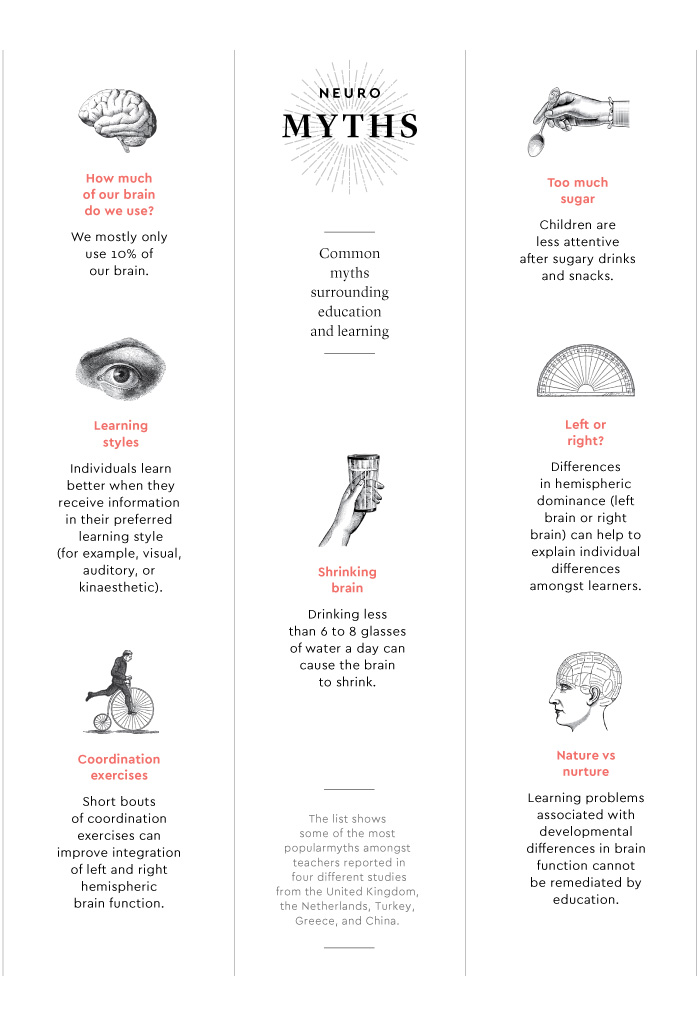
Learning
The Neuroscience of Learning
& The Global Learning Crisis
March 29, 2018
Across the world, governments are increasingly interested in developing a 21st-century education system that is supported by concrete evidence about how we learn. This is prompting a new and exciting dialogue between those in the fields of neuroscience and education.
Illustration by Pep Carrio
For a long time, research on understanding and developing new methods of learning has not moved as quickly as in many other areas. While transport engineering has moved from the horse to the spaceship, and medicine has moved from superstition to stem cells, changes in our approach to learning have been relatively modest.
By Paul Howard-Jones, Ross Cunnington, Amedeo D’Angiulli, Jérôme Prado, and Vivian
29/03/ 2018
·
- Share
Scientific technologies and concepts, particularly from neuroscience, are aiming to change that. Over the coming years, neuroscientists will be working collaboratively with staff at IBE-UNESCO to explore how current problems and needs in education can drive new directions for neuroscience research, and how neuroscience can feed into educational thinking, policy, and practice.
If ever there was a panacea for a nation, it must surely be education. Researchers have shown that educational achievement provides each of us with many benefits that also contribute to a nation’s economic growth, holistic development, and stability. Economic models show that the longer-term benefits of investing in education far outweigh the costs, through boosting productivity and innovation, as well as reducing crime (Doyle et al., 2009) and improving health (Cutler and Lleras-Muney, 2012). However, it is becoming clearer that the benefits do not arise from merely attending school but from learning (Benos and Zotou, 2014). On a global level, while many countries have increased the number of children attending school, the goal of ensuring educational quality has been more elusive (UNESCO, 2015). For example, around half or more of children completing primary schooling in many countries, including India, Bangladesh, Pakistan, Kenya, and Tanzania, are unable to read even the simplest texts or perform simple arithmetic. One economist has estimated that, at the current rate of progress, it will be well over 100 years before students in developing countries can produce results on science exams similar to those of today’s students in developed countries (Pritchett, 2013). If so much depends on the quality of learning, a new sense of urgency—combined with rigor—is needed in our approach to education and learning.
A scientific understanding of learning can aid education in several ways. First, authentic messages about how the brain learns can help dissipate the growing number of “neuromyths” that some educators hold. For example, some types of behavior do activate the left or right side of the brain more than the other, but it is simply a myth that we use the left side of our brain in one activity and the right side in another. The two hemispheres communicate with each other when we undertake even the simplest everyday task. Therefore, categorizing people as ‘left-brained’ or ‘right-brained’ takes the misunderstanding one stage further. It is also a myth that it is helpful to categorize students as visual, auditory, or kinesthetic, and then teach to their preferred learning style. There is no convincing evidence from neuroscience, psychology, or education that doing so is effective (Coffield et al., 2004; Kratzig and Arbuthnott, 2006). The brain is so highly interconnected and multisensory that even seeing the word ‘bell’ can activate the auditory cortex. Misunderstandings about the learning brain are commonly associated with poor classroom practice but they are popular with teachers across the world, even without any credible basis in science (Howard-Jones, 2014).
Second, and most important, brain science is now authentically informing new approaches to learning. This is a two-way venture: scientists can benefit from exploring their concepts in ‘real world’ environments, and educators can benefit by gaining insight into learning processes and practices. Techniques such as neuroimaging are allowing us to study brain function while learners acquire skills. By coming to understand the underlying processes involved in learning, educators and scientists are collaboratively developing neurocognitive interventions for both typical and atypical learners that should help them improve skills in literacy, numeracy, reasoning, and many other areas (Butterworth, Varma, and Laurillard, 2011). For example, researchers have found that we inherit ancient capacities that function as part of our “starter kit” for understanding particular areas of learning (Butterworth and Reigosa-Crespo, 2007; Dehaene et al., 2010).
This finding constitutes a real example of usable knowledge derived from neuroscience research with important implications for education. This knowledge can sensitize teachers to the ways their students develop these capacities, helping them to identify and accommodate the individual differences in their classroom. In addition, the knowledge helps teachers capitalize on these capacities whenever possible during instruction.
For example, neuroscience research provides insights into how these intuitions contribute to children’s learning of arithmetic—and this has very practical implications for the classroom (Dehaene and Cohen, 2007; Prado et al., 2011; Prado, Mutreja, and Booth, 2014). This research has stimulated intervention studies which that when students practice comparing quantities, their arithmetic skills improve (Hyde, Khanum, and Spelke, 2014; Park and Brannon, 2013).
Neuroscience research is also relevant to education in the reading domain. For instance, as children learn to read, a region of the brain becomes specialized to help them visually process letters. As they continue this learning, this region becomes connected to other areas that represent the sounds of speech. This supports an approach to teaching reading based on correspondences between the letters that represent sounds and the sounds themselves (the so-called grapheme-phoneme correspondence) rather than whole-word recognition. Therefore, cognitive neuroscience supports the early teaching of mastery of the sounds, leading to a detailed analysis of sound-print correspondence.
New technologies may also provide new ways to reveal more of what is occurring in the classroom, enabling a deeper understanding of issues related to learning or teacher practice in real-world school settings. For example, in a current study of the Australian Science of Learning Research Centre, over 600 students in primary and secondary schools in Brisbane are wearing wristbands to measure skin responses driven by the brain that are related to cognitive engagement, alertness, and stress levels. This study draws on computational methods (typically used in brain imaging)to examine “connectedness” between students, based on the degree to which they show the same biological responses at the same time, and are therefore commonly engaged (Gillies et al., 2016). Even in the real world setting of authentic classrooms, we can combine neuroscience and educational research to gain a richer understanding of how pedagogy or teacher practice influences the quality of education.
Third, if teacher training and development courses can include a basic grounding about how the brain learns, this promises to empower teachers to approach their own practice more scientifically. Teachers have a unique professional responsibility, every day, to influence the structure, functioning, and connectivity of young brains; this gives them a justifiable interest in understanding the processes involved. They constantly adapt their teaching to the learner(s) and the context, applying their own theories about their students’ mental processes and how they can influence these processes to scaffold learning (Mevorach and Strauss, 2012). Thus, a scientific understanding of learning should be regarded as fundamental to every teacher’s work. It has been said that trying to teach without understanding learning processes is a bit like trying to fix a washing machine without knowing how it operates (Dehaene, 2009). Of course, teachers are supporting learning behaviors that are much more complex than washing machines.
A scientific understanding of learning is also crucial for ensuring educational reform in a culturally diverse world; respect for such reform is emphasized by the Education 2030 targets, especially Target 4.7 (UNESCO and UNICEF, 2015). The ways that teachers respond to top-down reforms necessarily involve their own process of cultural adaptation; they integrate their own reflections, attitudes, and behaviors with the recommended changes (Berry, 2003). In other words, teachers will always adapt what they are given and make it their own. This undermines any belief that a one-size-fits-all approach to education reform can ever entirely succeed. The success of any reform will always rely, in large part, on teachers’ own interpretation of how learning works and, therefore, on their understanding of how best to adapt ideas for their own students. Although psychology and neuroscience work for and with each other, neuroscience is revolutionizing our understanding of learning by revealing a fresh perspective that combines mind and brain. Key concepts such as ability, disability, learning preferences, creativity, flexibility, and even intelligence, to name a few, can be described in the new light of differences in how individual learners’ brains work and how they adapt to their physical and social environments. Many factors, within and beyond the classroom, ‘sculpt’ the unique brain of an individual learner. This sculpting starts in utero, long before the child enters school, and also continues outside of school. Neuroscience is confirming that education is a major tool for this brain-shaping process, and for improving the transfer of knowledge across groups and historical time. Neuroscience is also introducing new dimensions that have not been linked, either traditionally or explicitly, to classroom learning, such as emotion, and underlying environmental, genetic, evolutionary, and biological variables; all these factors are potential constraints but also potential springboards for acquiring human learning and knowledge.
Of course, many challenges emerge in efforts to bridge the divide between education and the sciences of mind and brain. Some have expressed concern that this might lead to the type of ‘brain-based learning’ programs that were popular during the 1970s and 1980s—and that helped generate some of the neuromyths we have today. However, it is important to discriminate between these unscientific approaches and modern ventures that involve collaboration with authentic science. Indeed, this difference provides a strong argument for including the voice of authentic science in education, in order to support educators and policy-makers in discriminating between what is, and is not, authentic science. Others have suggested that psychology, rather than neuroscience, should inform education. This reveals a misunderstanding, however, since the neuroscience that is relevant to education is chiefly cognitive neuroscience, which has psychology at its core. While psychology builds theoretical models to explain and predict behavior, cognitive neuroscience validates and constrains such models, by demanding they align with evidence of concrete changes in brain function.
Perhaps the greatest challenge in this venture will be the dialogue itself: when it comes to discussing learning, education and the sciences of the mind and brain can employ different concepts and terms—almost a different language. For that reason, close dialogue and collaboration between experts in both fields are essential. Initiatives such as the IBE-UNESCO/IBRO fellowships are an important means to ensure this dialogue. Work has only just begun, but it is hoped that a more scientific understanding of learning will be both illuminating and empowering, for both science and education.
References
Benos, N., & Zotou, S. (2014). Education and economic growth: A meta-regression analysis. World Dev., 64, 669-689.
Berry, J. W. (2003). Conceptual approaches to acculturation. In K. M. Chun, P. Balls Organista, & G. Marin (Eds.), Acculturation: Advances in theory, measurement, and applied research (pp. 17-37). Washington, DC: APA Press.
Butterworth, B., & Reigosa-Crespo, V. (2007). Information processing deficits in dyscalculia. In D. B. Berch & M. M. M. Mazzocco (Eds.), Why is math so hard for some children? The nature and origins of mathematical learning difficulties and disabilities (pp. 65-81). Baltimore, MD: Paul H. Brookes.
Butterworth, B., Varma, S. & Laurillard, D. (2011). Dyscalculia: From brain to education. Science, 332, 1049-1053.
Coffield, F., Moseley, D., Hall, E. & Ecclestone, K. (2004). Learning styles and pedagogy in post-16 learning: A systematic and critical review. London: Learning and Skills Research Centre.
Cutler, D. M., & Lleras-Muney, A. (2012). Education and health: Insights from international comparisons. Cambridge, MA: National Bureau of Economic Research.
Dehaene, S. (2009). Reading in the brain. New York, NY: Viking Penguin.
Dehaene, S. et al. (2010). How learning to read changes the cortical networks for vision and language. Science, 330, 1359-1364.
Dehaene, S. & Cohen, L. (2007). Cultural recycling of cortical maps. Neuron, 56, 384-398.
Doyle, O., Harmon, C. P., Heckman, J. J. & Tremblay, R. E. (2009). Investing in early human development: Timing and economic efficiency. Economics & Human Biology, 7, 1-6.
Gillies, R. M. et al. (2016). Multimodal representations during an inquiry problem-solving activity in a Year 6 science class: A case study investigating cooperation, physiological arousal and belief states. Australian Journal of Education, 60, 111-127.
Howard-Jones, P. A. (2014). Neuroscience and education: Myths and messages. Nature Reviews Neuroscience, 15, 817-824.
Hyde, D. C., Khanum, S., & Spelke, E. S. (2014). Brief non-symbolic, approximate number practice enhances subsequent exact symbolic arithmetic in children. Cognition, 131, 92-107.
Kratzig, G. P., & Arbuthnott, K. D. (2006). Perceptual learning style and learning proficiency: A test of the hypothesis. Journal of Educational Psychology, 98, 238-246.
Mevorach, M., & Strauss, S. (2012). Teacher educators’ in-action mental models in different teaching situations. Teachers and Teaching, 18, 25-41.
Park, J., & Brannon, E. M. (2013). Training in the approximate number system improves math Proficiency. Psychological Science, 24, 2013-2019.
Prado, J., et al. (2011). Distinct representations of subtraction and multiplication in the neural systems for numerosity and language. Human Brain Mapping, 32, 1932-1947.
Prado, J., Mutreja, R., & Booth, J. R. (2014). Developmental dissociation in the neural responses to simple multiplication and subtraction problems. Dev. Sci., 17, 537-552.
Pritchett, L. (2013). The rebirth of education: School ain’t learning. Washington, DC: Centre for Global Development.
UNESCO (2015). Education for All 2000-2015: Achievements and challenges. Global monitoring report 2015. Paris: UNESCO.
UNESCO & UNICEF (2015). Education 2030: Incheon declaration and framework for action for the implementation of Sustainable Development Goal 4. Paris: UNESCO.






